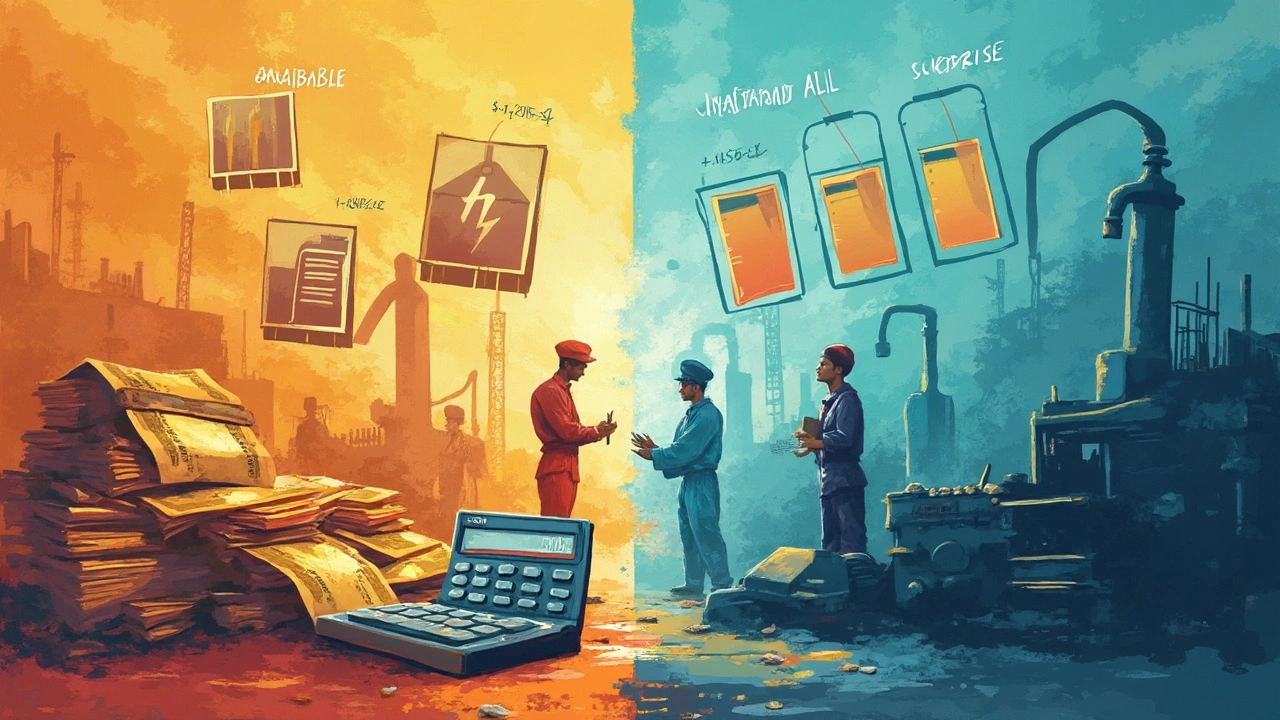Manufacturing startups have some jaw-dropping price tags before you even sell your first product. Most founders are surprised how fast costs add up, and one in four runs out of cash within the first year. Knowing where your money will go can save you from painful mistakes or overspending in all the wrong places.
So, what actually puts the biggest dents in your budget? We’re not talking about coffee machines for the break room. The expenses here are so chunky, they make or break your first year. Ignore them, and you’ll end up scrambling for funding or, worse, shutting down operations. But if you know exactly what to expect right from the start, you can plan smarter, negotiate better, and maybe even stretch your runway long enough to see real profit.
- Cost of Machinery and Equipment
- Facility and Utilities Overspend
- Payroll: The Price of Talent
- Hidden Costs That Sneak Up
- Money-Smart Tips for Staying Afloat
Cost of Machinery and Equipment
If you’re diving into a manufacturing startup, your bank account will feel the hit from machines and equipment way before any other expense. No matter the industry—whether it’s plastics, metal, or food—special machinery eats up a massive chunk of the budget. In fact, many founders spend around 30% to 50% of total launch costs just on setting up the production line.
What makes this expensive? It’s not just one piece of gear. Think conveyor belts, CNC machines, injection molding setups, ovens, or industrial 3D printers. Even basic automation tools can run you into the tens or hundreds of thousands. Plus, you’re also buying safety guards, power upgrades, and, for some industries, environmental controls.
Check out some actual starter price ranges:
| Machine Type | Low-End Cost | High-End Cost |
|---|---|---|
| Basic Assembly Line | $15,000 | $200,000+ |
| CNC Machine | $25,000 | $120,000 |
| Injection Molding Machine | $50,000 | $300,000 |
| Industrial 3D Printer | $10,000 | $250,000 |
Besides the machine itself, there’s rigging, shipping, setup, and training. Installation can cost an extra 10%-15% of the equipment’s sticker price, and don’t forget about software to run it all—licenses can stack up fast.
Want to save here? Try hunting for gently used equipment from auctions or plant closures. Leasing, instead of buying outright, is a good way to keep monthly spending predictable and free up cash for emergencies or other needs. But always check for hidden costs with used gear—repairs, missing manuals, and compatibility issues can burn you if you’re not careful.
One last thing—budget at least 10% of your machinery costs for regular maintenance. A machine breakdown can shut your line and drain your wallet fast. If you’re bootstrapping, partner with someone who knows the equipment or negotiate service contracts from day one.
Facility and Utilities Overspend
You’d think buying machines is the pricey part, but where you keep them can quietly drain your wallet. Renting or owning a proper space for your manufacturing startup isn’t just about having a roof and four walls. Between the rent, insurance, lighting, heating, and even internet, the costs just keep piling up. In cities like Houston and Chicago, small manufacturing spaces can easily cost $7,000 or more per month. That’s before you flip a single switch or unpack your gear.
Utilities are just as sneaky. Heating and cooling can slice thousands off your bottom line every month, especially if you’re running heavy machinery. According to the U.S. Energy Information Administration, power bills for small to midsize manufacturing facilities averaged nearly $72,000 per year in 2023. That doesn’t even count water, waste removal, or those surprise infrastructure fixes everyone seems to forget about.
“Many new manufacturers underestimate total facility costs—planning for just rent without the full picture,” says Lisa Adams, founder of LeanStart Manufacturing Advisors. “It can torpedo cash flow faster than any other budget item.”
Want to dodge the worst of it? Be picky with your location. Industrial parks on the city fringe are often cheaper than downtown, and they might throw in better utility deals or tax breaks. And don’t forget to ask about the age of the building—older places might look like a bargain up front but chew through your cash in repairs and wasteful energy bills.
- Negotiate your lease for early exit options in case you need to scale up or down fast.
- Run an energy audit before you sign—sometimes local governments offer them free.
- Bundle insurance with maintenance plans if you can; it keeps those “surprise” expenses in check.
It’s easy to get fixated on machines and ignore the boring facility line items. But if you play it smart, this is one area where you can save big in your manufacturing startup budget—not just spend big.

Payroll: The Price of Talent
For any manufacturing startup, your workforce is both your biggest asset and one of your biggest expenses. Payroll isn’t just a line item—it can eat up as much as 40-60% of your total operating budget in the first year. And it’s not just about salaries. There’s overtime, insurance, training, and those annoying government taxes that hit you even before you turn a profit.
If you try to cut corners and go cheap, you’ll likely pay more in the long run. Messy production, higher error rates, and staff turnover will stress your bottom line. A 2023 survey by the National Association of Manufacturers reported that skilled machinists in the U.S. earn an average base salary of $52,000, not counting overtime or benefits. Mechanical engineers cost even more, often crossing $80,000, and a floor supervisor averages $72,000. Entry-level roles (like assembly or packing) are cheaper, but even those get expensive when you hire in quantity.
| Role | Average Base Salary (US, 2023) |
|---|---|
| Skilled Machinist | $52,000 |
| Mechanical Engineer | $80,000 |
| Floor Supervisor | $72,000 |
| Entry-Level Operator | $36,000 |
Don’t forget the "hidden" payroll costs:
- Payroll taxes (Social Security, Medicare, unemployment)
- Health insurance and workers' comp
- Paid time off and sick leave
- Mandatory safety and process training (which can cost up to $2,000 per worker every year)
Startups in manufacturing can quickly get buried if they don’t map out real numbers for payroll. One handy tip: spend time upfront outlining exactly how many shifts, what skill levels, and seasonal needs you’ll face. Tempted to hire friends or family? Think twice—if they’re not experienced, you’ll just end up fixing mistakes or overworking yourself to cover gaps.
If cash flow is tight, many startups use contract workers or temp agencies at first. While hourly rates are higher, you avoid long-term commitments and most extra benefit costs. Still, having a reliable core crew who "get" your process is what sets winners apart from the startups that just burn through cash and staff.
Hidden Costs That Sneak Up
No matter how carefully you plan, there are expenses in a manufacturing startup that seem to come out of nowhere. These aren’t even the flashy ones like new machines or fancy building leases. Often, they’re things you didn’t even think about until the invoice lands in your inbox.
Take maintenance, for example. Most industrial machines run for about 2,000 hours before they need serious servicing, according to most manufacturer specs. If you skip budget planning for maintenance, an unexpected breakdown kills your cash flow and delays your shipments. It’s pretty common for new founders to underestimate yearly maintenance costs—they can run up to 5% of your equipment’s price, and that’s if you’re lucky.
Then there are regulatory costs. Setting up shop means complying with work safety, pollution controls, fire codes, and local zoning rules. Miss a permit renewal, and you could face shutdowns or big fines. For instance, back in 2023, over 45% of small manufacturing businesses reported surprise fees tied to new safety or environmental updates.
Insurance is another pain point. Basically, if you forget to get full coverage—liability, property, workers’ comp—a single accident can wipe out your cash. Some areas require coverage even before your doors officially open, and rates often jump after your first claim.
Quality control leftovers add up too. Think of the cost in time and raw materials when products don’t meet standards or are accidentally damaged in shipping. Even small errors can double your rework expenses overnight.
- Factor in working capital for delays—customers are slow to pay, but your suppliers want cash up front.
- Software, ERP subscriptions, and cybersecurity expenses rise as you grow, especially with more employees handling sensitive data.
- Waste disposal is a regular cost most ignore at the start. Hazardous waste is pricey to get rid of thanks to tough environmental laws.
Building an emergency buffer is more than just good advice—it’s a lifeline. Set aside at least 10% of your starting budget for unexpected bills. Plenty of businesses have kept their lights on just because they prepped for costs that no spreadsheet ever showed.

Money-Smart Tips for Staying Afloat
Stretching your funding and surviving your first year in a manufacturing startup comes down to some real-world money moves. Here are practical ways to hold onto your cash while keeping your project moving.
- Lease or buy used equipment: Why burn your cash on brand-new machines right away? Half of new manufacturers slash setup costs by finding quality used equipment or leasing instead of buying. This keeps thousands in your pocket for emergencies or upgrades down the road.
- Keep a lean team at launch: Payroll will eat up as much as 25-40% of your monthly costs. You don’t need a full staff on day one. Hire only the most essential roles at first, then bring in more people as orders ramp up. Consider contractors or part-time staff to fill gaps.
- Negotiate everything: Don’t just accept the first quote on materials, rent, or shipping. Manufacturers who shop around and play suppliers against each other can cut their supply expenses by 10-20%. Simple rule: If it’s not nailed down, negotiate it.
- Start small with your facility: Instead of signing a long lease on a massive production space, try a shared facility or flexible arrangement. Some startups even partner with other small manufacturers to split space and costs. This keeps your fixed costs lower and gives you room to pivot if needed.
- Track every penny: Stick to a basic accounting software or even a spreadsheet from day one. Missed small expenses stack up fast—39% of failed startups blame running out of cash for their exit. Schedule weekly budget check-ins and flag every cost jump before it grows.
Here’s a quick look at average monthly expenses for early manufacturing startups (based on recent U.S. data):
| Category | Low Range (USD) | High Range (USD) |
|---|---|---|
| Machinery & Equipment | $5,000 | $30,000 |
| Facility & Rent | $2,000 | $10,000 |
| Payroll | $4,000 | $15,000 |
| Utilities | $500 | $3,000 |
| Materials & Supplies | $3,000 | $20,000 |
Your survival isn’t about never spending—it’s about spending smart. Keep your setup flexible, your costs visible, and your deals sharp, and you’ll have a much better shot at turning those first-year hurdles into real traction.





